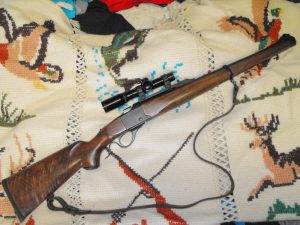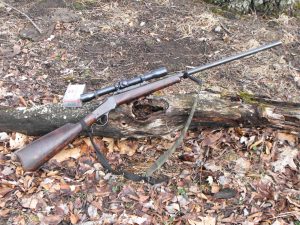Walt’s Campfire
Copyright
Walt Hampton
1-15-19


NOTE: I am retired from commercial gun stock work; I now only keep a hand in as a hobbyist, making the occasional stock for family members. I did make the stocks for all of the firearms in this article, in that I took God’s work and just cut away everything that didn’t look like a gunstock.
Gun stock choice is a matter of personal preference; under some circumstances nothing but synthetic materials make sense, but for your humble correspondent nothing compares to a good piece of real wood.
Wood that is to be used for gun stocks has to have certain characteristics to meet the unique needs of strength, character and beauty. Black walnut has long been the wood of choice for gunstocks, because of its density, grain structure, color, figure and strength. Most American firearms manufacturers, who experienced their zenith during the period from 1880-1960, used eastern black walnut from many areas, including Missouri, Pennsylvania, Kentucky and Virginia. For a few years walnut was hard to find.
Good straight-grain walnut, without any fancy figure, was at one time preferred for the furniture industry as well as for utility grade or field firearms. During the post-WWII years up to the late 1970’s, the furniture industry in western North Carolina and southwest Virginia bought every stick of straight-grain walnut that would make a 2”X 2” board. Walnut prices were up. Then, in the 1970’s with the advent of trade with China and later, Mexico, the furniture industry in this region died. Now with the popularity of synthetic gun stocks and the loss of the furniture industry, many times outstanding walnut goes to the woodstove.
Straight-grain walnut may be either slab or quarter sawn, and make a very strong, very long-lasting gun stock. If taken from heartwood and without sapwood, it will generally have good color and will take stain or the various finishes well. Many gun stocks made even for the utility-grade firearms around the turn of the 20th Century are just as strong and beautiful today as they were when first turned. If protected from moisture, and if the wood was properly dried and laid out to begin with, there is no reason that a good walnut gun stock shouldn’t outlast several generations of owners of a particular gun.
The American eastern black walnut, Juglans niger, is a slow-growing, long-lived tree species. It has moderate water requirements, does best in deep limestone soils on moist sites and is a shade-intolerant species. It can attain monarch proportions with many trees living well over 200 years and reaching a diameter of over 5 feet. These old monsters have been known to provide literally thousands of board feet of top-quality lumber per tree. One tree we cut in Alleghany County North Carolina produced over 900 board feet of usable stock blanks from three 8-foot logs! The walnut was the hallmark of the homestead; many times these huge trees were found in yards or fencerows of 18th and 19th Century home sites, providing a wind break, shade and of course walnuts for the residents. In considering these trees for gun stock work, one must also remember to be careful to “metal-detect” the trees; many times they will carry wire, farm implements, bullets and other bits of metal that can damage a saw blade. One tree we cut in Grayson County had all of these, and some of the most spectacular fancy wood we had ever seen, around those healed-over wounds.
Fancy figure in walnut is an anomaly. You see, the tree does not care if any fancy figure is found in its fiber; this is not to say that trees have conscious thought, but that the tree, through evolution, only cares to have strength and resilience to stand under the pressure of its own weight and resist the vicissitudes of the elements where it grows. Fancy figure, in the form of fiddleback, feather, or burl, only occurs where there is a bole imperfection, such as where a knot is formed around a wound, where a limb forms a crotch, where a virus has infected the wood cells during growth or where the weight and pressure within the stem folds and refolds the fiber, such as within the stump or where a root joins the stump. Wood from these areas is (generally speaking) less strong than straight grain and many times contain flaws such as voids or bark inclusions. Fancy figure can be found in most tree species, as most tree species can have the same flaws, but in walnut these figure elements can be particularly beautiful and wondrously colorful because of the unique color of walnut heartwood. Generally speaking, the older and larger the tree, the more potential there is that fancy figure will be found in it.
In order to make a quality gun stock, the wood must be properly laid out, properly sawn and properly dried. In judging where fancy figure will be found in a log, the sawyer must use intuition, best guess, and a healthy dose of luck to try to maximize the figure in the blank, and make sure the blank is laid out properly for gun use. For long rifle stocks and shotgun and rifle butt stocks, the grain must run up through the length of the grip or wrist to maximize the strength of the stock. Grain that runs across the wrist or grip may split with recoil or a sharp blow, or chip at the toe of the stock or pistol grip. When cutting blanks for stocks I always
looked for strength first, then figure; however, on some outstanding, highly-figured pieces I have cut them to take advantage of the visual impact of the figure, using the stock for a low or moderate recoiling firearm to protect it from coming apart under use. I just couldn’t stand to waste those fine pieces and not use them! Also, in some fancy pieces, you might get away with repairs to flaws using glass epoxy or shellac sticks, and still have a very usable and beautiful gunstock for your efforts.
When we would cut a tree we sawed the bole into slabs lengthwise, from 2 ½” to 4” thick, the width and length of the log. These we stored in our barns in the slab, spaced so each could get full air exposure in that dry environment. I liked to do it this way, instead of the conventional method of sawing the blank out of the slab right away and drying the blank, because I wanted the wood to tell me where the weak places were; where it would split, check or come apart. Wishful thinking cannot make a good blank—it is what it is, and you can’t fool Mother Nature. We dried these slabs until they were below 10% moisture and never cut a stock from a blank that was higher than that percentage, and really wanted them to be around 6%, but that was hard to accomplish in the Appalachian Mountains of SW Virginia, with the higher elevation, higher humidity of our area. A word on drying: many commercial walnut operations use a kiln to steam-and-dry their gun stock wood; while this certainly works and is much faster than waiting the 4 to 6 years it takes to air-dry a slab, it also sucks a lot of the natural color out of the wood. I have seen some spectacular wood from kiln operations, but for the most part I prefer wood dried passively.
As previously stated, in the log, fancy wood is found in two general areas:
1) where there is a bole defect, such as crotches (where limbs meet the trunk), knots or areas healed over around damaged areas;
2) in or just above the stump; most burl comes from in the stump where the roots join it. Lots of pressure here in large trees, and a hell of a lot of moisture. We had stump wood we sawed into 4″ thick slabs at the time the tree was felled and after 4 years of in-the-barn drying, we literally still had water run out of them and puddle on the shop floor when we attempted to saw the slabs into blanks. (My little single shot low wall stock was a piece of this stump wood not big enough for anything else, a tiny corner of solid wood where a root joined the stump.) The furniture industry wants straight-grain, from logs with no defects. That is why usually at the mill you can buy the crotches and defect wood so cheap (unless there are gun builders that live in the area!).
Burl and fancy wood with figure like feathercrotch or fiddleback is usually concentrated near the defect and it is very, very hard to find a piece that will lay out properly for strength, i.e. the grain running through the grip in the proper direction, and still have enough wood to make a stock, and even more rare when that figure runs through the thickness of the blank from side to side and shows up on both sides of the blank. Slab-sawed wood usually has the best color and figure, but quarter-sawed wood can be spectacular. You will get figure in more slab-sawed wood than in quarter-sawed wood (in my experience). No two blanks are the same, and no fancy blank has the exact same amount of figure on both sides of the blank.
There is a difference between showy grain and fancy figure. Fancy figure is (in black walnut) fiddleback or feathercrotch, and like the name implies comes usually from the crotch areas of the log. Burl is just burl, grain going every which way, a result of pressure, damage or time. This is why most burl is in small pieces and so rare. You can have a blank with good color and grain flow, but no fancy figure, and still have a beautiful stock. Add in the fiddleback though, or a feathercrotch, and wow, we’re talking about a miracle of nature.
Since there is no standardized grading system for gunstock wood, when we were in business we graded our walnut as follows: straight grain (no fancy figure); A grade (up to 25% fancy figure in the butt—average both sides of butt); AA grade (up to 50% fancy figure average both sides of butt); AAA (up to 75% fancy figure average both sides of butt); Exhibition (100% fancy figure both sides of butt). Turned to your pattern of choice prices starting with straight grain and going up were $100-$150-$250-$350-and exhibition was priced individually up to $1000. It takes one hell of a piece of wood to be worth $1000 (in my opinion).
Finding a piece that has it all, proper grain flow for strength, good figure on both sides and good color, is worth every penny it costs. The next time you are in the market for a new long gun or considering a custom build, give walnut some consideration; I doubt you will be disappointed.








